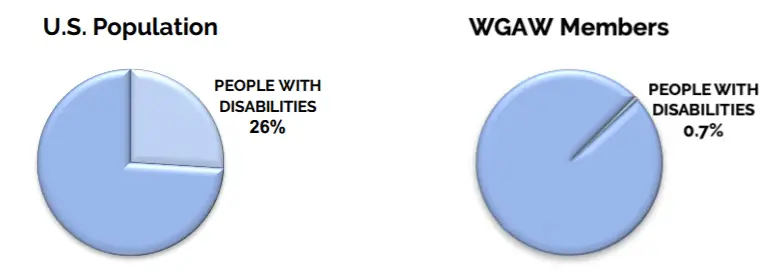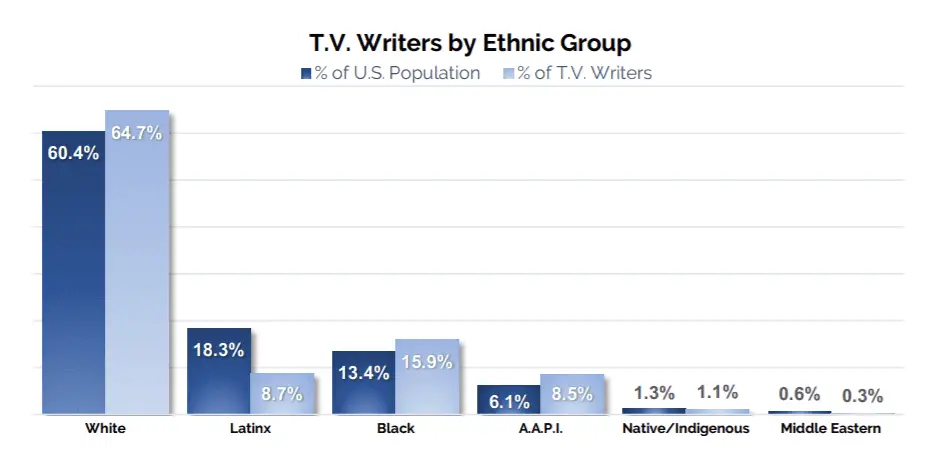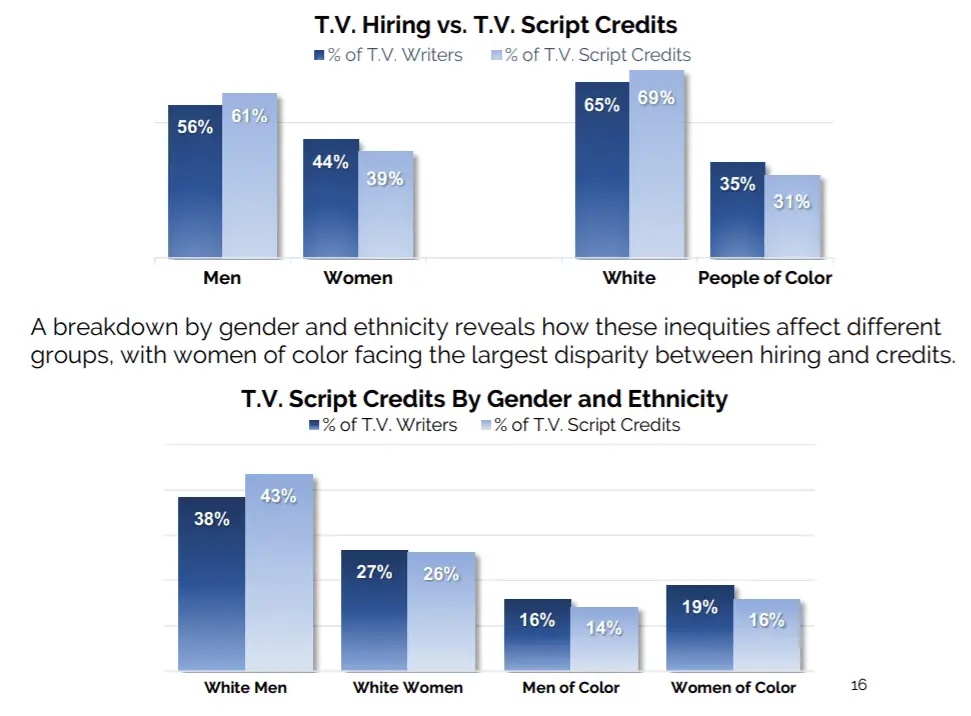The Writer’s Guild of America West (WGAW) released its 2020 Inclusion Report on June 5th which chronicles the lack of diversity in writers’ rooms across all levels and all types of TV. Now, this data is always important and the explicit links between lack of inclusive writer’s rooms and what’s shown on-screen are consistently made. However, in the light of protests against police brutality worldwide (and network responses showing “support”), it is absolutely imperative to point out how non-inclusive writer’s rooms continue to create content that further marginalizes Black people as well as other groups!
For example, though POC made up 49% of staff writers, only 18% are showrunners, a 6% increase from the 2017-18 season! The report also breaks down disparities between men and women, disabled writers, people over 55, and LGBTQ writers. For example, only 30% of showrunners are women (and one can assume very few are Black women).
There are so few disabled writers that the data isn’t even broken down further. When more than a quarter of the US population is disabled, only 0.7% of WGAW writers self-reporting a disability is an incredible disparity. Across the board, all of these marginalized groups face discrimination at all levels of writing.

While people over 55 make up 29% of the total US population, they only accounted for 12% of TV writers in the last TV season. Though I have not seen any detailed data about actors above 55, I bet the numbers are similarly awful especially on networks like The CW or Freeform who are supposedly aimed at younger viewers. (The CW’s youngest median age is barely 48 years old.)
To be clear, though Black writers and AAPI writers make up larger shares in TV employment than compared to their US populations, it does not mean that both writer groups don’t face bias especially when their bosses are usually white men or white women . Indigenous writers only make 1.1% of writers and Middle Eastern writers are 0.3% of writers.

The WGA report does not break POC down further so it is unclear exactly how many writers by level are Black, Latinx, Indigenous, or Middle Eastern. Obviously 18% POC as Showrunner or 19% POC as Executive Producer is nowhere near equitable compared to White writers at the higher levels. For example, at the three highest title levels, POC had the highest “representation” at 33% of Co-Executive Producers in comparison to making up 62% of Story Editors. If this was broken down by men of color and women of color I’m sure the disparities would become even more apparent. In fact, there are 3% fewer men of color writing compared to women of color!

Of course, even though all the percentages quoted above highlight the persistent disparities in the industry, breaking it down further by episodic script assignments really gets across how absolutely ridiculous it is that there are POC repeating roles multiple times, but not getting to take on a higher role. As the report notes
The number of scripts a writer is assigned plays an important role in determining the trajectory of her career. Thus T.V script credits are another important measure of inclusion and equity.
If there are so few writers of color in the WGA in the first place, and they get even fewer episode credits, how long will it take for them to “move up” the ladder? Sounds like a bad math problem. Though POC make up 35% of writers in WGA, they only had 31% of the script credits! Breaking it down by men and women of color shows that men and women both write less compared to their white counterparts.
Black writers held nearly 16% of the writing jobs but received just 12.8% of the script credits. The report is not granular enough to know how this plays out for Black men and Black women (as one example) and I think that data would tell an even more grim story (hah) about who is receiving credits (and chances to add to their resume). Hopefully future reports will really break down the data so we can see the full picture. Even if POC are writing scripts, they have no power to change plotlines massively or push back against their (likely) white showrunners.

The WGA report also includes a breakdown by writers across the six studios the majority of TV comes from (at least on broadcast) with WB having 42% writers of color, but that does not indicate that they’re giving writers script credits. Unsurprisingly CBS Studios only has 33% writers of color and they pump out the majority of the cop shows on TV accessible to millions of people in the US and worldwide.
In context of what’s happening in nearly every metropolitan city in the US right now (and even in some suburbs), it’s important to point out that even if the writer’s rooms were truly at parity for women, writers of color, those older than 55, and LBGTQ writers (and for all the people who are one or more of those categories), that wouldn’t fundamentally change the genre. Thus, it’s not shocking that the representation of Black, Latinx, and other marginalized groups on cop shows are awful.
Color of Change’s January report titled Normalizing Injustice is a “comprehensive study of how television’s most popular genre excludes writers of color, miseducates people about the criminal justice system and makes racial injustice acceptable” explores the data at the deepest level on 26 series airing in the 2017-18 season. It is absolutely worth the read, whether you watch procedurals or not.
For example, only 9% of the writers across the crime series analyzed were Black and 81% of the showrunners were white men. Even shows we all love like Elementary are included in the report and the conclusions point to what a number of critics and reporters have written about in wake of the protests. Procedurals are just as culpable because they make cops the main characters, have taught us to valorize the police, and model police behavior. Though this WGA report does not touch on procedurals in specific, a number of the shows on the WGA 101 Best Written TV Series are procedurals.
I myself just wrote a 2500 word review of Prodigal Son on Fox, and while I stand by my conclusion that the show is one of the only to truly process a character’s trauma and do it well, it’s still a cop show!
All this to say that until writers of color (from all backgrounds) reach parity with their white (and straight and younger and abled) counterparts at every level of writing on TV, every show, procedural or otherwise will continue to misrepresent marginalized groups no matter how hard some might try not to.
Even Warren Leight, current showrunner of SVU acknowledges that even if he tries to make the show not be a problem, collectively procedurals are miscontributing to society. The interview linked is actually really illuminating and indicates that he like most people doesn’t think that certain shows will do a dang thing differently in the fall.
The WGA report does note that if upward trends continue women and people of color will reach parity in TV employment within the next two years. Though it’s unclear how that time frame changes if broken down further. Honestly, there’s gotta be a better way of categorizing writers (or any people). The phrase women and people of color implies doesn’t actually say anything when for example, Black women are in both groups! Reports of this nature must delineate between white women, women of color, and men of color (and further) since women alone does not paint the true picture. Plus, white women are as culpable for bad behavior and plot.
Obviously there are a number of surveys and studies that have shown that there’s a number of issues like bias, tokenism, and harassment that writers from underrepresented groups face. Additionally, even showrunners from the underrepresented groups listed in the report have perpetuated much of the harm against their own writers so there is much to do to create long-term and legitimate change.
That change includes studios paying their writers (and support staff) properly without using COVID as an excuse to drop their pay, firing showrunners who allow unsafe workplaces to flourish (especially if they’re the aggressor themselves) and truly giving a damn.
Finally (though certainly, the list of steps is long), networks need to buy projects from people other than the Berlantis of the world, because those productions continue to hire from the same pool of people, further create disparities between new writers and long-time writers and showrunners. All this applies to screenwriting as well which the WGAW report includes similar data for.

